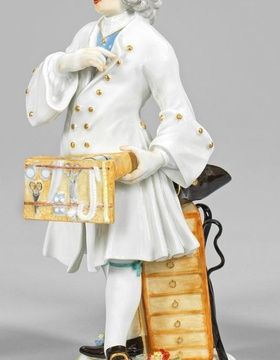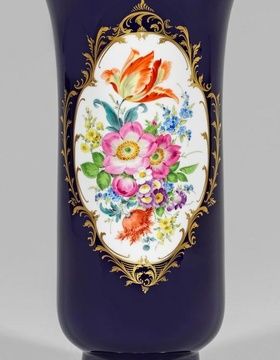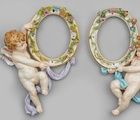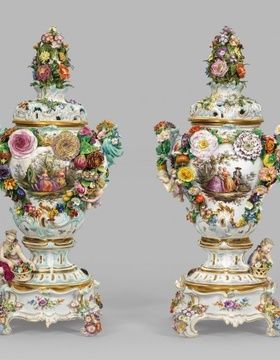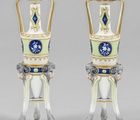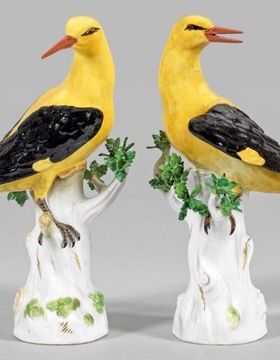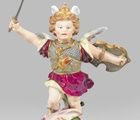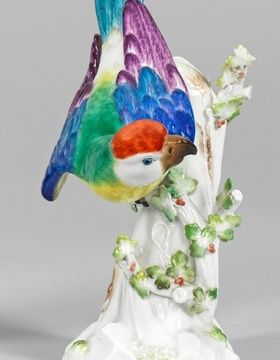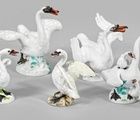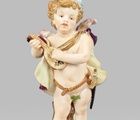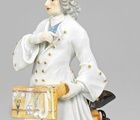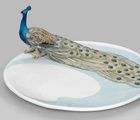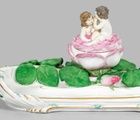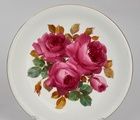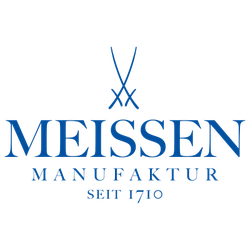
Произведения знаменитой Мейсенской мануфактуры «Meissen» – это уникальные предметы искусства высокого художественного уровня и королевского стиля, имеющие мировую известность и коллекционную ценность. Каждый из периодов трехсотлетней истории интересен в своем развитии, наполнен важными для художественного наследия событиями и яркими открытиями.
«Белое золото» - так называли европейцы китайский фарфор, навсегда покоривший их сердца своим необыкновенным изяществом и красотой форм и тайной своего происхождения. Впервые китайский фарфор привезли в Европу португальские купцы. Историки датируют этот факт 1508-м годом . С тех пор европейские ученые-алхимики искали секрет состава уникальной фарфоровой массы.
Первым, кто добился долгожданного результата, был алхимик Иоган Фридрих Бёттгер. В 1707 году он получил твердую массу, пригодную для формовки, обжига, шлифовки и нанесения краски из глины и красной земли. Полученный им материал из-за характерного оттенка стал называться «красной массой». Понадобилось еще два года, и Бётгер совместно с физиком и геологом Чирнхаусом вывели, наконец, формулу знаменитого белого фарфора, основанную на местном сырье – белой глине, залежи которой были обнаружены вблизи Дрездена. Именно этот важный уникальный компонент фарфоровой массы отвечал за ее пластичность.
На следующий год рядом с месторождением в городе Мейсен была открыта первая в Европе фарфоровая мануфактура, владельцем которой стал король Август Сильный. Его величество так трепетно относился к своему новому предприятию и дорожил секретом «белого золота», что перевез завод в замок, а к мастерам приставил охрану. Первые фарфоровые изделия появились в 1713 году, однако их качество оставалось низким, поверхность была неоднородной, бугристой, а кое-где намечались разрывы. Мастерам приходилось обильно декорировать предметы лепным декором. Их покрывали глазурью, а в качестве примера брали китайские образцы. Но совсем скоро слава о высоком качестве мейсенского фарфора заставила забыть об этом коротком периоде неудач.
В 1719 году не стало Фридриха Бёттгера; на его место был назначен Иоганн Грегор Херольд – успешный живописец с Венской мануфактуры. Благодаря ему, качество производства фарфора вышло на новый, более высокий уровень. Это коснулось технологических усовершенствований, а также способствовало появлению новых предметов роскоши. К великолепным сервизам и вазам добавились скульптура, изящные фигурки, табакерки, мушечницы, всевозможные шкатулки, часы, туалетные и письменные приборы, трубки для курения.
Мануфактура обеспечивала нужды двора и эстетические потребности немецкой аристократии. Совсем скоро почти вся Европа была охвачена фарфоровым бумом. Саксонский король Август был самым взыскательным заказчиком произведений из фарфора. Для украшения интерьеров своих дворцов он не скупился ни на финансирование производства, ни на собственную фантазию. Одними из самых оригинальных предметов стали фарфоровые скульптуры животных по их естественным пропорциям. Этот блестящий замысел короля выполнял сам Иоганн Кендлер.
В 1722 году у мануфактуры появилась марка, ставшая впоследствии самым знаменитым знаком качества – два скрещенных меча.

1730-е годы стали временем расцвета мейсенского фарфора. В 1733 году на фабрику пришел мастер Иоганн Иоахим Кендлер, и его назначили ведущим скульптором. А в 1735 году управляющим мануфактуры становится Генрих Граф фон Брюль - премьер-министр Саксонии. Это был период стиля рококо, создания удивительных и разнообразных по форме предметов интерьера, парадной декоративной скульптуры и изысканных фигурок. Предметы украшаются богатым орнаментом и лепными деталями, подчеркивая роскошь и великолепие придворного стиля. К этому времени относятся столовые сервизы, выполненные по заказам Иосифа Графа фон Сулковского и Генриха Графа фон Брюля, состоявшие из более 2000 предметов. Именно тогда входит в моду традиция украшать обеденный стол фарфоровыми фигурами, изображающими национальных героев, крестьян в костюмах, арлекинов, знатных дам. Костюмированные фарфоровые фигурки стали не только любимым детищем Кендлера, но и визитной карточкой мейсенского производства. По этим ярким, выразительным по мимике и пластике персонажам можно было судить о моде и нравах того времени.
Столовые и чайные сервизы 1740-х годов становятся более изящными, в росписи доминирует цветочный мотив. Это самый характерный для мейсенского фарфора стиль, когда по белому полю фарфора разбросаны букеты и одиночные цветы. В рельефном декоре фарфоровых изделий появился мотив ивовой плетенки различных видов. В росписи ваз наряду с цветочным мотивом появляются пейзажная и жанровая темы, выполненные по мотивам гравюр и известных живописных произведений с оригиналов Д. Тенирса, Антуана Ватто, Георга Ругендаса.
Новый период на фабрике был связан с эпохой классицизма с его строгостью форм и сдержанностью декора. Это время связано и с деятельностью нового скульптора француза Мишеля Виктора Асье, вдохнувшего в мейсенскую пластику новые идеи. Пышный лепной декор, характерный для предыдущего периода, уступил место архитектурным элементам. В своем художественном решении произведения все больше тяготели античным образцам. В росписях ваз стали преобладать аллегорические и мифологические сюжеты, а сами формы напоминали классические амфоры и кратеры. В 1774 году на фабрику приходит граф Камилло Марколини - саксонский министр и любитель искусства, который около сорока лет состоял в должности управляющего. При Марколини появляется новая марка – мечи и звезда под ними. Фарфор этого периода несколько уступает предыдущему. Жесткость форм произведений, периодическое копирование образцов других европейских заводов заметно снизили уровень мейсенской продукции.
При Наполеоне фабрика не только изменила свое название на «Королевскую саксонскую мануфактуру», но и переживала период кризиса, из-за которого она едва не закрылась.
После наполеоновских войн началось последовательное возрождение мануфактуры. Карл фон Оппель, сменивший Марколини, управлял предприятием в 1814-1833 годы и реформировал технологический и художественный процессы. Главным же достижением этого времени считается изобретение «жидкого золота» Генрихом Готлибом Кюну. Созданная им прочная глянцевая эмаль и некоторые другие составы красок по фарфору оживили палитру мейсенских изделий. Середина XIX века – время пейзажной и жанровой живописи, которая украшала парадные вазы и сервизы. Мотивы росписи мастера брали с образцов академического искусства. Особенно популярны были картины таких мастеров, как Юлиус Шнорр фон Карольсфельд, Готфрид Земпер, Эрнст Ритшель. С 1860 годов началась эпоха историзма, мастера все чаще обращались к произведениям в стиле рококо и барокко, что возродило былой дух и славу знаменитого мейсенского фарфора.
Искусство модерна в фарфоре нашло благодатную почву для воплощения свежих идей. Одним из мастеров нового стиля стал Конрад Хенчель, который в 1896 году придумал дизайн «Крокус». Предметы с этим оригинальным мотивом были показаны на выставке в Париже в 1900 году и имели большой успех.
В начале ХХ века производство обновилось новыми творческими силами. Молодые мастера разрабатывали для повседневных предметов рисунки, которые потеснили традиционную роспись. В это время создаются удивительные по красоте скульптуры и предметы мелкой пластики, художественное решение строится на поиске гармонии в сопоставлении цветочного мотива и женского образа.
После первой мировой войны мануфактура значительно расширила свой ассортимент за счет разнообразных моделей. Большую роль в этом сыграл художник Пауль Шойрих, создавший больше сотни новых фигур, в которых соединились традиции рококо и ар-деко. Под впечатлением Русских сезонов Дягилева была создана известная серия фигур «Русский балет». Современный фарфор по-прежнему не теряет своей актуальности и коллекционной ценности. Формы изделий традиционны, росписи повторяют старинные образцы и в то же время варьируют новые разработки рисунка. На фабрике по-прежнему работают талантливые мастера, бережно относящиеся к своему великому наследию.
Аукцион искусства и старины art-picture.ru предоставляет возможность покупки
приобрести представленны лоты по теме "Meissen /Мейсен/"

